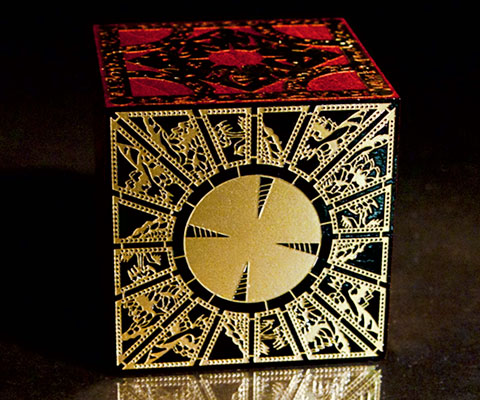
You opened the page, so I came. Regular readers may recall I recently ranked the Halloween series and the Friday the 13ths, then judged the Jurassic Parks. Lately I’ve gotten to know a Hellraiser fan (a dying breed), with a big fridge for beers, so we’ve gradually watched the lot. Consequently, I thought I’d go through them here, so you don’t have to. Hellraiser’s a funny franchise in that few seem to actually like it, yet the makers have gotten away with 10 movies over a period spanning four decades. Like Children of the Corn and Amityville, it appears to exist and crank out cynical sequels despite minimal interest from the horror community or film-watchers on the whole. For instance, years back I tried to watch them, and got bored after five. Still, as per Elm Street (which I may revisit in future) there’s no denying the central idea itself has a lot of allure. So let’s look at how it’s been done ’til now. Some of the films are so bad, that they’ll tear your soul apart. Yet when it’s good the franchise has such sights to show you.
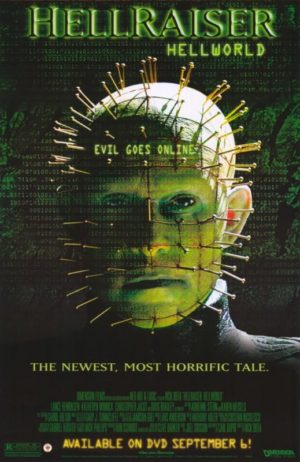
10. Hellraiser: Hellworld (2005): The videogame one. Or at least it should be. Aside from prividing a loose excuse to gather its cast together (which includes a young Henry Cavill), the game concept is barely mentioned. It’s not that people being stuck in a Pinhead themed virtual world would be good per se. But it’d potentially have allowed the movie to feature the kinds of environments not seen since the second – instead of a mansion. Yes, in this Hellraiser-slasher hybrid, some kids’ gaming prowess lets them go to a sexy party where they get offed on by one by Lance Henrikson. It’s a clunky setup, raising questions about if inventing a competition, and hosting a shindig, is an efficient way to kill people. More importantly, it fails to appropriate the series to the new subgenre neither hitting the key slasher beats nor using the postmodern setup effectively at all (it’s unclear whether the Hellraiser films exist in this world, or just the game). The characters are thinly written, and truly unremarkable. It’s not that you relish seeing them die, which is a common slasher trick to make the audience enjoy them, as much as you don’t care. At all. Not that the deaths are well devised or captured anyway. Rick Bota’s by then signature twisted camera angles are more annoying than effective and can’t disguise how boring the story he’s telling is. Plus by part 8 in a series, when the bad guy would usually be at the forefront as the recurrent element, it’s frustrating to see the cenobites so clearly underused. Pinhead, for what little we see of him, has very little menace left and no creative lines or kills. To top it off, there’s an ending so bad it can surpass even the lowest expectations, with the sort of twist only a masochist could enjoy.

9. Hellraiser: Revelations (2011): The one everyone hates. And with good reason. Made solely so the Wesinstein Company could keep the rights, for the long-awaited remake, this movie is 100% product. Viewer enjoyment comes second to corporate greed to the extent that any enjoyment is probably a happy coincidence. The iconic Doug Bradley who had done 8 prior movies, passed on the script (and the shockingly low salary he was offered) so was replaced by babyfaced Stephan Smith Collins, whose more sassy than scary. His face is about the only new thing in it. The plot is a complete rehash of the first and the characterisation is maybe the franchise’s worst – among other things, there’s incidental sort-of incest that’s straight outta leftfield. There’s also a frankly bizarre inclusion of the cenobites seemingly stealing cars and cutting the phoneline. Famously shot in under two weeks, director Víctor García plays with found-footage throughout – presumably to save time – as he charts two affluent teens trying to find the ultimate high. Yet he bafflingly encompassing it in an omniscient flashback, with the brother-fucking protagonist somehow seeing both when she looks over the footage at a dinner party. At 75 minutes, the movie still drags – with the poor narrative decision to treat the working of the box as a plot twist meaning the backing story goes well into the second half. Still, the skinless teens and the blooded mattress at least bring the series back to its roots, meaning it at least feels distinctly like a Hellraiser flick. Albeit a bad one.

8. Hellraiser: Deader (2003): The one with the cult. As per some of the other sequels, Deader did not begin life as a Hellraiser , with an original script getting loosely adapted. I say ‘original’, though after two movies where a protagonist has to figure out what’s real and what isn’t, the series looks long in the tooth by playing off the same tension. It’s frustrating, as the opening act where our plucky reporter Amy goes to Romania to investigate a cult, which brings the dead back, has real potential to it. There’s a few good horror scenes, and some pretty effective sets the long departed Barker may have approved of – if he even watched it. However, it’s soon forgotten for yet another psychological meltdown that dominates the second half, leading into the confusing final act. Supposedly the leader of the Deaders group wants to get rid of Pinhead, but doesn’t want to get his soul torn apart. But if someone who’s already died summons him, then they can stop him once and for all, for reasons not explained. Particularly if this zombie was molested by their father during their first lifetime because… Urgh. To call it convoluted is an understatement. Returning director Rick Bota has, to his credit, a music-video visual flair that’s probably better here than either of his other sequels. Not that it necessarily makes much difference for a story where plot and motivations are afterthoughts.
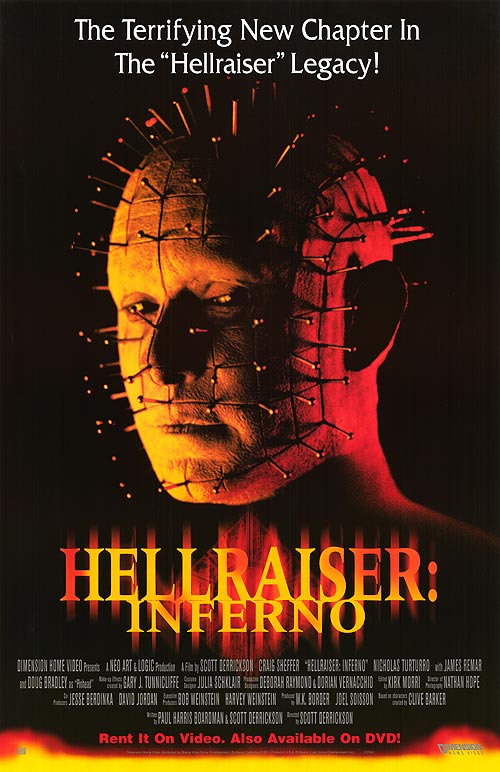
7. Hellraiser: Inferno (2000): The arty one. I remember really liking it first time, with Scott Derrickson’s direction giving it a real nightmare-noire look (he would later go on to make Sinister and Doctor Strange). Some of the surrealism is genuinely quite gripping, with cool cenobite designs and interesting use of lighting and sound throughout. So it’s a tehnical triumph, if style over substance. Similarly to Deader, its biggest weakness is in its script. Inferno was the first of the mind-fuck films, charting the psychological deterioration of a hardboiled cop, named Thorne, who’s chasing a murderous spectre named The Engineer. The use of the Hellraiser brand means the audience are already at act three whilst he stumbles through the first (if you haven’t seen it, you can probably guess who the killer is). When the revelations finally come, in the last five minutes, it unfolds as you’d expect save for a contrived bit of symbolism that gets spelt out. As subtext becomes text, the bit-part Pinhead seems to take on a Judeo-Christian role of moral arbiter – what happened to demons to some and angels to others? This is not the only way Inferno breaks away from established rules, with Pinhead inexplicably killing before the box has been opened. The aftermath of it being opened also in no way resembles the prior four. Throw in a dull, tropey anti-hero, a silly ninja fight scene and some terrible over-acting, and the movie’s messier than a cenobite’s browser history. It could have been a passable film in its own right, but not for this franchise.

6. Hellraiser: Hellseeker (2002): The one where Kirsty Cotton comes back. For me, this is a guilty pleasure if ever there was one – where pleasure and pain intersect. Essentially replicating the plot of Inferno, with a gruff male protagonist trying to figure out what’s real, but with the additional twist that he’s lost his memory. His amnesia co-occurs with the death of his wife (the returning Kirsty, going underused), which is either supergood or superbad depending how you look at it. But did he really kill her? What makes it so enjoyable is the bonkers plotting that was likely intended as sincere, but makes it so bad its good. I’ll try and avoid too many spoilers. But when we find out what went down, it’s a plan that needlessly involves a third party who has none of the cost, risk or responsibility yet claims 50%. There’s also half a dozen strange sex scenes, with every woman Thorne meets wanting to give him some pleasure. There’s a person shooting himself, in an unconventional attempt to intimidate Thorne – if he’s willing to kill himself just think what he’ll do to him! Then in a not so shocking twist, two cops that both think he’s the murderer are actually the same person: a reveal with such little impact I don’t feel even slightly guilty about spoiling it. I get that none of this is meant to be funny, and it may seem a double standard to condemn Inferno for some of the things I’m praising here. However, this time around the tone is less self-serious and its stupidity extends to the whole 90 minutes vs. some odd smatterings. The ending, when it comes, sees the Kirsty/ Pinhead reunion being a huge anti-climax. Oddly, I think I like it better that way.
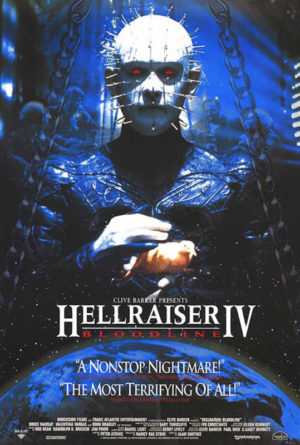
5. Hellraiser: Bloodline (1996): The one in space. Bloodline can’t be flawed for its promise, taking place over three different times lines centuries apart, it follows one family’s relationship to the box. Yet the box itself has never been less interesting. Rather than the Lament configuration itself being demonic, the box just so happened to be sitting in the room during a magical ceremony. It could have as easily been an enchanted piece of ham for all the difference it’d make. The present day part is standard Hellraiser, but more condescend so really able to breathe. Then the space sequences are oddly enjoyable, providing an epic scope and a true ending to the series, though the finale feels rushed. Allegedly the movie was chopped and changed a lot by the studio, hence the Alan Smithee name attached. The budget was also dropped, with this final cinematic outing showing you can’t do the iconography and concepts Hellraiser on a shoestring. Nowhere is it more obvious than the closing scenes that do a disservice to all that’d come before. Still, there’s a tonne of cenobite action, with the inclusion of Angelique being enjoyable, and the plot is engaging. It’s also fun to see a youthful Adam Scott ham it up. A semi-decent film, and a must rent for fans of the first three. But with such an interesting premise it’s maybe one of the clearest missed opportunities in all of horror. Ambition over achievement.
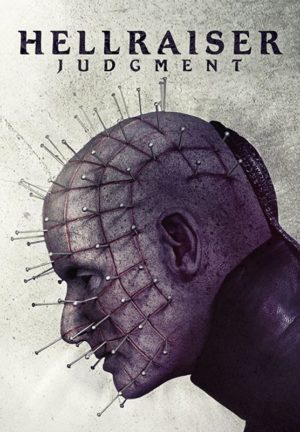
4. Hellraiser: Judgement (2018): The recent one. And by far the goriest of the films. Writer/ director/ actor Gary J. Tunnicliffe had done special effects for several other entries, and here lets himself run wild. The opening act is stomach-churning body horror. There’s one piece of hellish imagery after another, as corpses are destroyed in increasing creative ways. It’s almost a relief when the pace slows down, and the police procedural starts up. Unfortunately, it’s also the weakest element, with the detective narrative being clichéd and not handled with the imagination shown elsewhere. Thematically, Judgement is in line with the rest of the straight to video sequels, and like them there’s a twist towards the end that’s sort of unexpected but doesn’t feel important. Still, credit where its due – Tunncliffe knows the iconography and really pushes it in new directions with a consistent sense of otherworldy nastiness. The Order of the Gash (tee-hee) finally feel like bad guys again, and put the Hell back in Hellraiser. The new Pinhead doesn’t even get in the way, being serviceable. An unexpected pleasure. Perhaps most intriguingly, the ending is fresh and offers a lot of potential for a follow-up. But please, whatever you do Dimension and Miramax, don’t call back Bota!
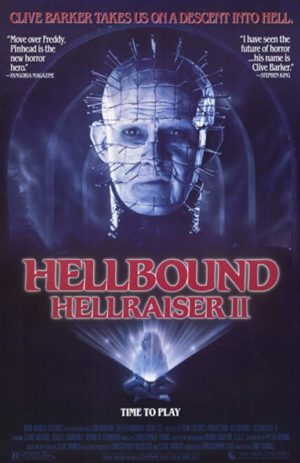
3. Hellbound: Hellraiser II (1988): The one in Hell. As per the second Purge, Hellbound makes the first movie’s narrow focus look like a proof of concept for something far larger. Although the original briefly visited Hell, it seemed to consist solely of a single room and corridor. This time, Tony Randell opens up the universe to meet the idea’s full potential with Escheresque impossible geography. Ashley Laurence is back as Kirsty, who is now confined to a mental hospital where one of the doctors opens the portal via a certain magic box. In she goes, with her mute puzzle-loving friend/ Checkov’s Gun, to find her dear old dad. The first half is suspenseful enough, if very slim on story, whilst the second is visually unrivaled among other entries. There’s also some really cool ideas for Hell too, like individuals having their own personal areas. Unfortunately, the avant-garde style eventually becomes overwhelming, at the expense of the narrative. The last cenobite is harrowing. But my main gripe is the actual content of film’s third act gradually unravels, with key elements going under-explained and the denouement gettingrushed. Still, when building upon a confined horror, like Hellraiser, this is how to do it.
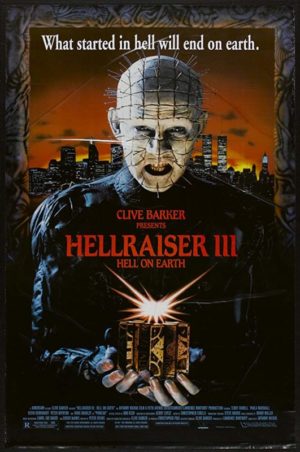
2. Hellraiser III: Hell on Earth (1992): The one with the goofy cenobites. On initial viewing, I couldn’t get behind part three – it’s got an MTV aesthetic, and the decision to trap Pinhead in a pillar was maddening. Yet coming back to it, older and wiser, I’m impressed by how much threat Doug Bradley gives the character despite being immobile for large parts. It’s very much his movie, with Bradley booming out his best speeches. He’s no longer a monosyllabic face, but a better rounded horror villain. There’s also a successful attempt to expand on the series lore by having him play Pinhead pre-Hell too. When he’s finally freed, a moment that can make even casual fans cheer and airpunch, the quality of kills is immense. Hell on Earth toeing the line between fun, visual trickery and horror well, offering an action quotient, and all round busier feel, than any others. Elsewhere, the corruption of JP is well handled, even if he’s manipulated a tad too easily, and reporter Joey’s a likable lead with a decent arc. Granted, some of the other demons are embarrassing, with one hurling discs at unsuspecting citizens and another making terrible puns. Though there’s a real pleasure to seeing cars go up in flames and a whole club hooked and chained up. I expect a lot of will disagree with this placing above the second, I feel the storytelling is tighter and the third act more cohesive. Nonetheless, I like all three, and sort of wish the films had ended here.
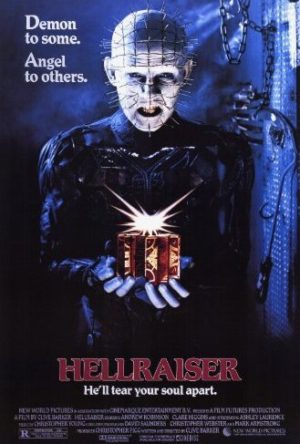
1. Hellraiser (1987): The one that came first. By far the best in the franchise, and very maybe among the all-time great horrors. Intellectually, I’ve known it’s good for a while but on rewatching it – wow! Barker’s original is dark, stylish and visually astonishing. The pace and acting are both solid, with the domestic tale about infidelity and hubris perfectly integrated into an eerie horror – all because someone didn’t move a mattress properly. It’s smaller-scale than other entries, with the action focusing on an unfaithful wife helping the walking corpse of her deceased lover via a series of murders. Hellraiser is all the better for its size, with the juxtaposition of Ibsen drama and eternal damnation being inspired. The one true love angle isn’t especially moving, given Frank’s a piece of shit. But the Autumn-years feel, where Julia has only memories of shacking up with her brother in-law to keep her tantalized, is tragic. That she loves him, despite him being skinless, is also oddly body-positive. Against Kirty’s exciting first love, the boring companionship of her dad’s marriage creates a sense of sadness that makes the story relatable, if not realistic. All of central performances are excellent, with the cast equally selling the fantastical premise and human element. Andrew Robinson and Clare Higgins excel as an unloving couple, and the former is like a totally different person in the third act when he’s playing the sleazy Frank in the same body. Ashley Laurence doesn’t have too much to work with, as her character has very little arc, yet she maintains a magnetic presence during her plight. In an era where the genre had begun to embrace silliness, with wisecracking killers, its great to see a movie so uncompromisingly grave. The hellish iconography is also as good as it gets, with some of the models and props being outstanding. Really, it’s tough to believe it was a feature-debut. Barker creates such an atmosphere or dread and a debauchery, dealing in an emotional and ethical complexity that the series fails to match. Sure, maybe some of the effects towards the end are dated – but you’ll be so invested it doesn’t matter. Now if someone can just explain to me why Frank keeps the damn box after coming back…
Well that’s all from me. For now I’ll turn into a winged Hellbeast and fly off. Do let us know what you think of the ranking, and when it comes to the movies, what your pleasure is.



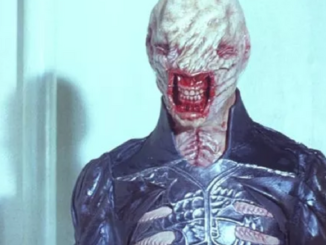

Be the first to comment